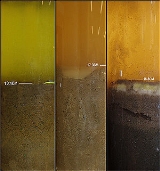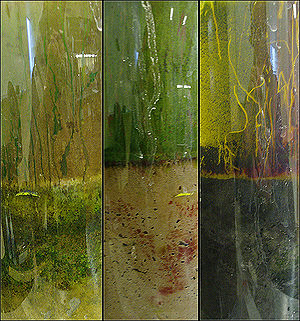
Winogradsky column
Encyclopedia

Microorganism
A microorganism or microbe is a microscopic organism that comprises either a single cell , cell clusters, or no cell at all...
s. Invented by Sergei Winogradsky
Sergei Winogradsky
Sergei Nikolaievich Winogradsky was a Ukrainian-Russian microbiologist, ecologist and soil scientist who pioneered the cycle of life concept. He discovered the first known form of lithotrophy during his research with Beggiatoa in 1887...
, the device is a column of pond mud and water mixed with a carbon source such as newspaper (containing cellulose
Cellulose
Cellulose is an organic compound with the formula , a polysaccharide consisting of a linear chain of several hundred to over ten thousand β linked D-glucose units....
) blackened marshmallows or egg-shells (containing calcium carbonate
Calcium carbonate
Calcium carbonate is a chemical compound with the formula CaCO3. It is a common substance found in rocks in all parts of the world, and is the main component of shells of marine organisms, snails, coal balls, pearls, and eggshells. Calcium carbonate is the active ingredient in agricultural lime,...
) and a sulfur
Sulfur
Sulfur or sulphur is the chemical element with atomic number 16. In the periodic table it is represented by the symbol S. It is an abundant, multivalent non-metal. Under normal conditions, sulfur atoms form cyclic octatomic molecules with chemical formula S8. Elemental sulfur is a bright yellow...
source such as gypsum (calcium sulfate
Calcium sulfate
Calcium sulfate is a common laboratory and industrial chemical. In the form of γ-anhydrite , it is used as a desiccant. It is also used as a coagulant in products like tofu. In the natural state, unrefined calcium sulfate is a translucent, crystalline white rock...
) or egg-yolk. Incubating the column in sunlight for months results in an aerobic/anaerobic
Hypoxia (environmental)
Hypoxia, or oxygen depletion, is a phenomenon that occurs in aquatic environments as dissolved oxygen becomes reduced in concentration to a point where it becomes detrimental to aquatic organisms living in the system...
gradient as well as a sulfide gradient. These two gradients promote the growth of different micro-organisms such as clostridium
Clostridium
Clostridium is a genus of Gram-positive bacteria, belonging to the Firmicutes. They are obligate anaerobes capable of producing endospores. Individual cells are rod-shaped, which gives them their name, from the Greek kloster or spindle...
, desulfovibrio
Desulfovibrio
Desulfovibrio is a genus of Gram negative sulfate-reducing bacteria. Some species of Desulfovibrio are capable of transduction. Desulfovibrio species are commonly found in aquatic environments with high levels of organic material, as well as in water-logged soils, and form major community members...
, chlorobium
Chlorobium
Chlorobium is a genus of green sulfur bacteria. They are photolithotrophic oxidizers of sulfur and most notably utilise a noncyclic electron transport chain to reduce NAD+...
, chromatium
Chromatium
Chromatium is a genus of photoautotrophic Gram-negative bacteria, also known as purple sulfur bacteria, which are found in water. These bacteria oxidize sulfide to produce sulfur which is deposited in intracellular granules of the cytoplasm. They also couple oxidation of other metals, like iron, in...
, rhodomicrobium, beggiatoa
Beggiatoa
Beggiatoa is a genus of bacteria in the order Thiotrichales. They are named after the Italian medic and botanist F.S. Beggiato. The organisms live in sulfur-rich environments...
, as well as many other species of bacteria, cyanobacteria, and algae.
The column provides numerous gradients, depending on additive nutrients, from which the variety of aforementioned organisms can grow. The aerobic water phase and anaerobic mud or soil phase are one such distinction. Due to low oxygen solubility in water the water quickly becomes anoxic
Hypoxia (environmental)
Hypoxia, or oxygen depletion, is a phenomenon that occurs in aquatic environments as dissolved oxygen becomes reduced in concentration to a point where it becomes detrimental to aquatic organisms living in the system...
towards the interface of the mud and water. Anaerobic phototrophs are still present to a large extent in the mud phase, there is still capacity for biofilm creation and colony expansion, as noted by the images. Algae and other aerobic phototrophs are present along the surface and water of the upper half of the columns. Green growth is often attributed to these organisms.
Construction
The column is a rough mixture of ingredients - exact measurements are not critical. A tall glass or plastic tube (30cm long, >5cm wide) is filled one third full of pond mud, omitting any sticks, debris, air bubbles. Supplementation of ~0.25% w/w calcium carbonate and ~0.50% w/w calcium sulfate or sodium sulfate is required. Mixed in with some shredded newspaper or hay (for cellulose), ground egg-shell and egg yolk respectively are rich in these minerals. An additional anaerobic layer, this time of un-supplemented mud, brings the container to two thirds full. This is followed by water from the pond to saturate the mud and occupy half the remaining volume. The column is sealed tightly to prevent evaporation of water and incubated for several months in strong natural light.External links
- Animated tutorial by Science Education Resource Center — Carleton CollegeCarleton CollegeCarleton College is an independent non-sectarian, coeducational, liberal arts college in Northfield, Minnesota, USA. The college enrolls 1,958 undergraduate students, and employs 198 full-time faculty members. In 2012 U.S...
- Winogradsky column: perpetual life in a tube — Edinburgh University
Also see the pages of Winogradsky research group http://researchpages.net/Winogradsky/

